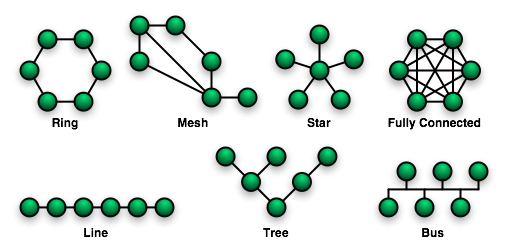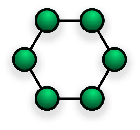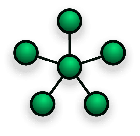Network Topology
From Computing and Software Wiki
| Line 76: | Line 76: | ||
==See Also== | ==See Also== | ||
[http://imps.mcmaster.ca/courses/SE-4C03-09/project/wiki-pages.html 4C03 Project Listing] | [http://imps.mcmaster.ca/courses/SE-4C03-09/project/wiki-pages.html 4C03 Project Listing] | ||
| + | [[Network]] | ||
| + | |||
==External Links== | ==External Links== | ||
*[http://en.wikipedia.org/wiki/Network_topology Wikipedia Article on Network Topology] | *[http://en.wikipedia.org/wiki/Network_topology Wikipedia Article on Network Topology] | ||
Revision as of 03:45, 13 April 2009
Network topology refers to the configuration of connections between the elements (links, nodes, etc.) of a network.[1] Network topology does not refer to the physical layout of a network, nor does it refer to transmission rates, signal types or other characteristics of computer networks.[2][3] Networks are normally organized by one (or more) of five basic types of topologies: bus, ring, star, tree, and mesh. In some instances two networks are interconnected forming a sixth type of topology: hybrid.
Contents |
Types of Network Topologies
Bus
The bus topology uses a single transmission medium which all messages are broadcasted on. Each node receives every message, but only the intended target accepts it. Only one message can be sent at a time on a bus network, otherwise a collision will occur, corrupting the message.
Advantages
- Simple to configure.[5]
Disadvantages
- A fault in the main connection medium can cause the network to fail. [5]
- Very unsafe. Each computer receives all messages on the network. A computer can still accept messages even if its address does not match the destination address leading.
- Is slow under heavy load, and can prone to collision problems.
Ring
In a ring topology each node is connected to exactly two other nodes forming a closed loop. Messages are passed along the ring in a single direction until they reach their destination.
Dual-ring network
Dual-ring networks contain two separate rings networks which pass messages in opposite directions. Generally, only one ring is operating at a time. This creates redundancy in the network so that if one of the rings fails backup ring will allow the network to continue to function.
Advantages
- Dual-ring networks are more reliable than bus, and other similar topologies. If a fault occurs in one of the rings, the network does not necessarily fail.
- Is relatively simple to configure.
Disadvantages
- Single-ring networks provide no more reliability than the bus topology.
- Due to all nodes wanting to send messages along the ring, issues concerning fairness arise.
- Is slow under heavy load.
Star
The star topology consists of a central node (hub, router, etc.) connecting the peripheral nodes of the network together. Each message passes through the hub and is redirected to its destination.
Advantages
- Easy to detect errors and faults in the network. Each node is separate from all other nodes, so it is easy to isolate and fix certain problems with individual nodes without affecting the rest of the network.[5]
- Any break in a connection between the central and peripheral nodes does not cause a failure in the network.[5]
- Minimizes the number of possible collisions.
Disadvantages
- If the hub has a fault, the entire network can fail.[5]
Tree
Combining the characteristics of multiple star networks along a single bus network using a root node forms the tree topology. The central node of each star network is connected to the root node of the tree creating multiple tiers on the network. Messages passing between star networks pass through the root node to their destination.
Advantages
- Easy to expand.
- Allows for much larger number of nodes than bus or star networks separately, while having the same speed and size limitations.
- If there is a fault in the root node, the connections within each of the lesser tier networks will not be lost.
Disadvantages
- If there is a fault in the root node, the connection between each of the lesser tier networks can be lost.[5]
- Is more complex some other topologies, and is more difficult to configure.
Mesh
Mesh topologies present multiple paths that a message can take to reach their destination. Each node is connected to one or more other nodes. If each node is connected to every other nodes then it is called fully connected or a full mesh. Messages are passed along the network by using a routing algorithm or table which determines the next node the message will take to reach its destination.
Advantages
- Creates inherent fault protection through the redundancy in connections between nodes. There is generally multiple paths from node to node. A mesh network fault will thus generally not cause a node from being disconnected from the network.
- May be easy to expand. Only a small number of nodes may need to have their routing algorithms/tables updates to expand the network if the network is small, or the expansion occurs in an outlying region of the network.
Disadvantages
- Can be much more complex than other topologies. As the size of a mesh network grows the number of connections can grow exponentially, with the most extreme growth rate occurring in full meshes, which have n(n-1)/2 connections.[4]
- If the routing algorithm/table is not properly implemented in any number of nodes, faults can occur. For example, lost messages and messages continuously passing through a cycle.
- May be very difficult to expand. As highlighted in a full mesh, all nodes will need to have their routing algorithms/tables updates to include the new nodes.
Hybrid Networks
Hybrids networks are networks that combine two or more of the basic types of topologies, such that a new type of network is created.[4] For example, connecting two bus networks together via a central node is a hybrid network, whereas simply combining two bus networks is not. A practical example of a hybrid network is found in many home networks. Networks that combine LAN and WLAN have elements of bus, ring, and star topologies that create a single network.
Centralization
A network is centralized if there exists a central node, usually a hub or router, through which messages are passed.[2] Both star and tree topologies contain these central nodes. From the central node, messages are redirected to the destination node, or at least passed in the direction of the destination node in the case of a tree. Each central node is responsible for knowing the address and routing information of each other node connected directly to it on the network. The peripheral nodes only pass messages to the central node. Centralized networks are far easier to expand upon than decentralized networks. When a new node, or set of nodes are added to an existing centralized network only the central node(s) needs to be updated in terms of routing information. Peripheral nodes take no part in routing messages thus is it not necessary to update them.
Decentralization
A decentralized network does not contain a central node, messages are passed directly from node to node.[2] Bus, ring, and mesh topologies are all decentralized. Decentralization is particularly important in mesh networks. The redundancy in mesh networks is due directly to the lack of central nodes, allowing up to all nodes to share a connection with all other nodes. Decentralized networks are generally more difficult to expand upon than centralized networks. The exception to this is the bus topology since all messages are broadcasted. However, in the ring and mesh topologies, routing information will need to be changed for each node affected. This is a particular problem with full meshes, with each node on the network requiring new routing information.
References
1. "A Guide to Network Topology" Learn Networking 2008 [1]
2. "Network Topology" Wikipedia 2009 [2]
3. "Network Topologies" About.com 2009 [3]
4. "network topology" ATIS 2007 [4]
5. "An Educator's Guide to School Networks, Chapter 5 Topology" Florida Center for Instructional Technology College of Education 2005 [5]
See Also
External Links
- Wikipedia Article on Network Topology
- A Guide to Network Topology
- An Educator's Guide to School Networks, Chapter 5 Topology
- Network Topologies on About.com
- Network Topology
--Liberag 23:29, 12 April 2009 (EDT)






